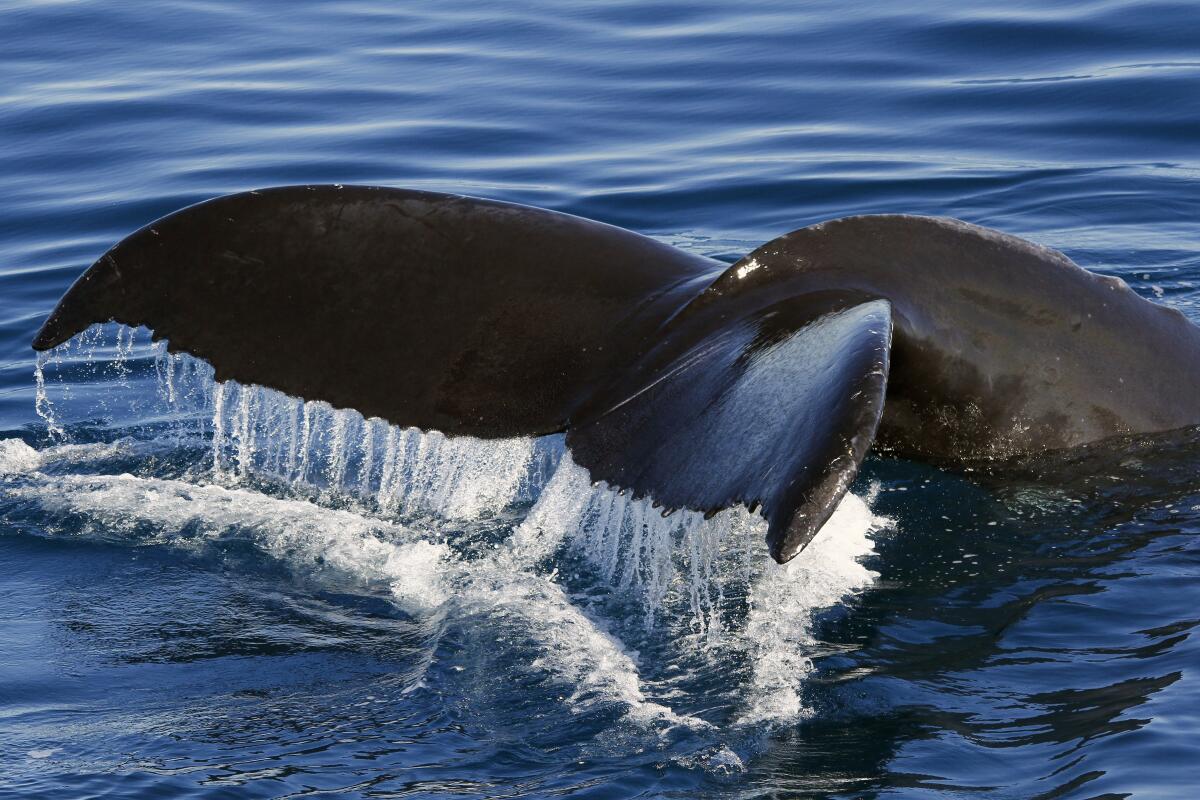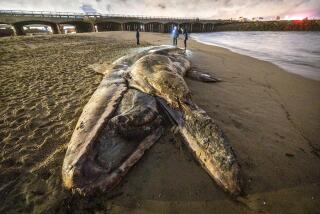Dana Point named first Whale Heritage Site in the U.S.

Two women who operate rival whale-watching tours in Dana Point came together to work on having their beloved slice of the coast named one of the whaliest places in the world. Their efforts paid off.
Dana Point on Wednesday became the first Whale Heritage Site in the U.S., a distinction it shares with Hervey Bay in Australia, the Bluff in South Africa and newly named Tenerife-La Gomera Marine Area in Spain. The designation acknowledges areas known for having cultural ties and respectful interactions with whales and dolphins.
“It really is something that will solidify Dana Point as the whale watching and dolphin capital of the world,” said Donna Kalez, co-president of Dana Wharf Sportfishing & Whale Watching. “It’s been a longtime dream.” Her father, Don Hansen, started whale-watching tours off Southern California in the 1960s and pioneered the first whale festival half a century ago — historical ties that put the Orange County coastal town in the running.
Gisele Anderson, vice president at Captain Dave’s, said the designation will attract visitors who want to see five species of whale and five species of dolphin that thrive in waters off the point. “We have more wild dolphin per square mile than anywhere else in the world,” Anderson said, noting that 450,000 common dolphin live between Southern California and Baja, Mexico.
Even so, that’s not why Dana Point became a heritage site.
Ben Williamson, programs director of World Animal Protection U.S., explained that sites are selected for other reasons. “It’s all about the heritage, the culture, the education and conservation sustainability,” he said. His global nonprofit organization partners with the World Cetacean Alliance in hopes of creating “a world where cetaceans only live in the wild, where they live in harmony with people.”
Both organizations oppose dolphins and whales being kept in captivity, where they are held in tanks much smaller than their natural habitat range and forced to perform tricks. The Whale Heritage Site program offers a chance for visitors to interact responsibly with animals and see them in the wild — and train future generations to seek authentic interactions too.
But back to the whales.
Dana Point visitors who take a tour as short as 2½ hours may see gray whales on their round-trip migration between Alaska and the warm waters of Mexico (now through May). In the 2000s, blue, fin and minke whales began to appear as well, making the area a year-round whale-watching destination.
Kalez and Anderson got the idea to raise the profile of Dana Point and its whale heritage when they traveled to other states and countries, including Alaska, Hawaii and Australia, to study their whale-watching operations. After comparing notes, the two realized Dana Point’s small natural harbor had access to more robust wildlife viewing than just about anywhere else.
“In Boston, they travel four hours to go out and see a humpback whale, and then travel four hours back without seeing anything else,” Kalez said. “The beauty of where we are is that we can travel seven miles to see a humpback whale and on the way back see four kinds of dolphins.”
The two women admit they were once fierce rivals, competing for tourist dollars and the best whale-watching spots off the coast. They set aside their differences a few years ago to capitalize on the common pride they have in their community and the mammals that have made Dana Point famous. Two years ago they worked together to trademark Dana Point as “The Dolphin & Whale Watching Capital of the World” from the U.S. Patent and Trademark Office.
“It was started by my dad and his love for the gray whales, and the fact they came by Dana Point harbor every year like the swallows coming back to San Juan Capistrano,” Kalez said.
Anderson quoted her husband, Capt. Dave, who compared Dana Point to the wild plains of the Serengeti. “Who goes to Africa and then goes to a zoo to see animals in captivity?” Anderson said. “But people come here and drive right by the Serengeti of the ocean to go see them in captivity.”
Dana Point whale-watching tours
Capt. Dave’s takes visitors on six vessels, including a high-speed catamaran sailboat called the Manute’a for 2½-hour whale and dolphin tours every day. Tickets cost $65 for adults (13 and older) and $45 for children. Capacity aboard the 49-person boat is limited, and masks are required because of the COVID-19 pandemic. The company also offers tours in small Zodiac crafts. Info: Capt. Dave’s
Dana Wharf Sportfishing & Whale Watching has several boats in its fleet and offers two-hour tours that cost $56 for adults 13 and older and $39 for children. The company also abides by COVID-19 protocols that include reduced capacity on boats and mask requirements. Info: Dana Wharf Sportfishing and Whale Watching
This year marks the 50th anniversary of the Dana Point Festival of Whales. The event, usually held over two weekends, will be limited to March 6 and 7 this year, partly because of the pandemic. It will feature virtual and in-person events. More info: Dana Point Festival of Whales
More to Read
Sign up for The Wild
We’ll help you find the best places to hike, bike and run, as well as the perfect silent spots for meditation and yoga.
You may occasionally receive promotional content from the Los Angeles Times.







